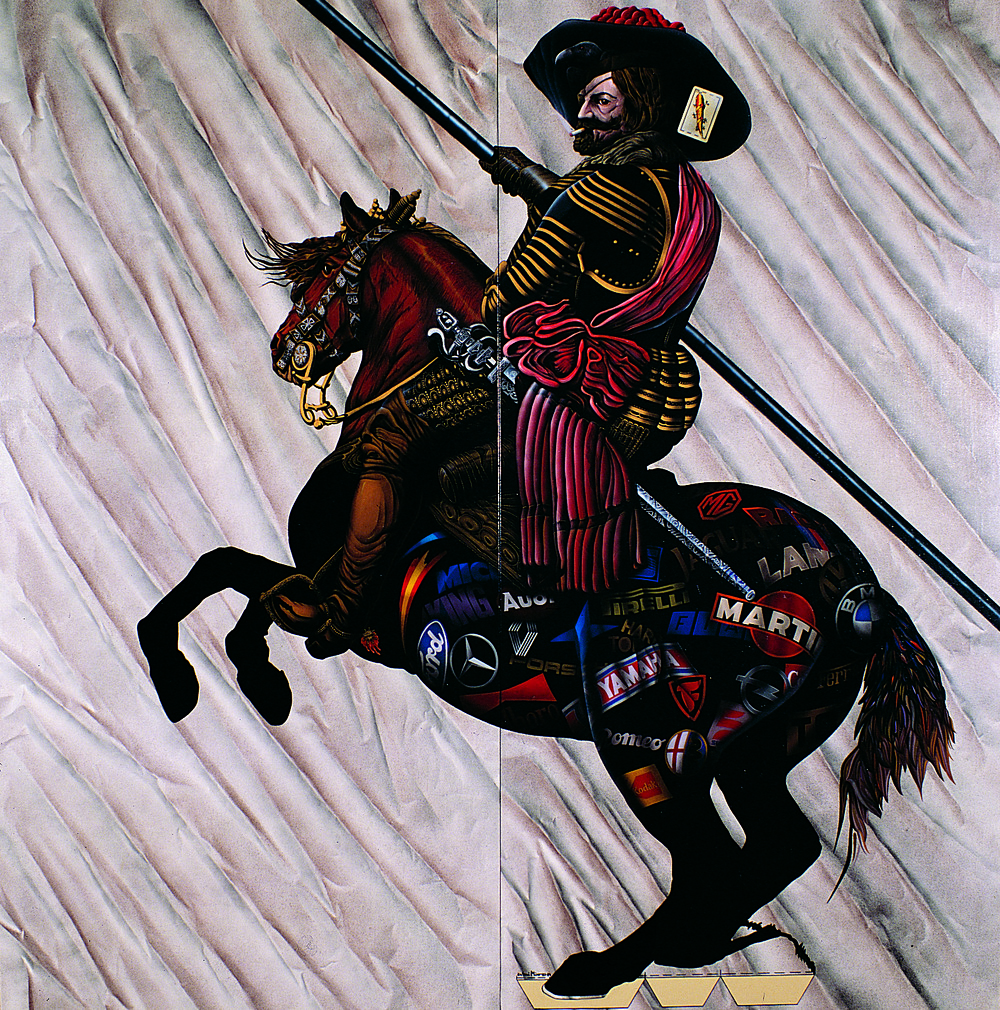Retrat eqüestre (Equestrian portrait)
This is one of the most singularly representative works in the ‘Paint Painting’ series, which was executed during the nineteen-eighties. Through it, Antoni Miró made political criticisms by pictorially transforming masterpieces from the art history canon, combining these icons with uses and pieces from the visual culture of the moment.
The diptych has a very carefully worked background that looks like crumpled paper or fabric. The folds or creases create a texture of diagonal chiaroscuro alignments. A ‘cut-out’ figure is placed on this background, depicting an altered version of the portrait of Gaspar de Guzmán, which was painted by Velázquez in 1636.
The extraordinary power that the Count-Duke of Olivares wielded as the strong man behind Felipe IV made him a symbol of political domination in later culture. His administrative reforms sought to boost the unity of the Spanish monarchy by forcing the Castilian language and culture on the lands of the Crown of Aragon and on Portugal. His efforts are considered a precedent for the kind of Bourbon Centralism that within a century was to promulgate various Royal Decrees. Antoni Miró has tirelessly denounced the resulting loss of autonomy and the destruction of citizens’ rights in Catalonia, Valencia and the Balearic Islands.
The topic of the painting is a reproach of political domination and mercantilism. In the artist’s view, contemporary society is doubly subjugated by the State and by consumerism. This is why he paints a symbol of Spanish political power galloping on the backs of the economic empire of multinationals.
Symbols of evil appear next to the rider’s head. There is part of a crow in the Duke’s hat which, though visually discreet, is powerful in symbolic terms. The same happens with the Duke’s eyepatch, and the cigarette hanging from his lower lip gives the figure a modern, cocky touch. The ace of clubs card indicates his iron-fisted control.
The horse’s rear is plastered with the logos of various big company brands, most of them for cars but there are also names of tobacco, beverage and photography firms. All of the logos come behind a ribbon bearing the colours of the Spanish flag. As Roman de la Calle discerningly notes, “the Paint Painting series’ strange obsessions stir up history and the everyday, the heritage that accompanies our gaze and the memory of our roots, but it does so through aesthetic experience, not only as a means but as a cohesive value of all this diversity of levels”.
The artist’s critical outlook upon which the work is based is clearly linked to an aesthetic position as well. Miró’s appreciation of the work by the master painter from Seville is patent given that he paints all the elements in the work in fine detail. The reins, spur, breastplate, sword, the knotted sash are all carefully defined, modifying the expressive language of the original.
Other alterations, such as the chromatically-enriched horse’s tail and the replacement of a general’s baton by a lance reaching beyond the canvas, pursue other goals. The more colourful tail helps offset the vibrancy of the logos, while the lance enhances the diagonal aspect of the horse’s rampant position, which is also achieved by the lines traced in the background.
Santiago Pastor Vila
